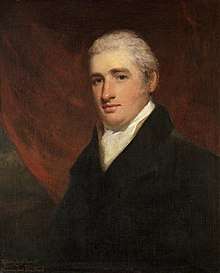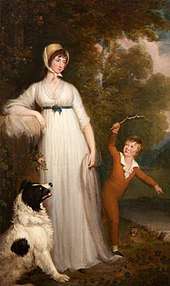Sir Henry Hugh Hoare, 3rd Baronet
Sir Henry Hugh Hoare, 3rd Baronet (1762–1841) was an English banker, a partner in Hoare's Bank, with a particular interest in the affairs of the Church of England.

Life
He was the son of Sir Richard Hoare, 1st Baronet and his second wife Frances Ann Acland; Sir Richard Colt Hoare, 2nd Baronet (1758–1838) was his elder half-brother.[1] He was born at Barn Elms. According to his obituary in the Gentleman's Magazine, he was known as Hugh.[2] Charles Hoare was his younger brother. His sister Henrietta Anne married Sir Thomas Dyke Acland, 10th Baronet.[3]
Hoare was elected Fellow of the Royal Society in 1784.[4] He became a partner in the family bank in 1785.[5] Henry Hoare of Mitcham Grove (1750–1828) became the head of the firm c.1788.[6] On the death in 1787 of his father, Hoare had inherited the family house at Barn Elms, but he did not reside much there. It was sold in 1827, to the company constructing the Hammersmith Bridge.[7]
In 1789 Hoare purchased a London house on St James's Square.[5] His friend George Elphinstone Keith was married in 1808 from this house, to Hester Thrale.[8]
In 1797 Hoare bought an estate at Wavendon, Buckinghamshire.[5] The mansion house there had been in the Selby family for several generations, but had changed hands, and Hoare bought it from Lord Charles FitzRoy. He added further property.[9] An improving farmer, Hoare was noted for his drainage and the use of the Scotch plough.[10]
When Henry Hoare of Mitcham Grove died in 1828, Hugh Hoare succeeded him as senior partner of Hoare's Bank.[11] New premises on Fleet Street, designed by Charles Parker, were opened in 1829, the work having been under the oversight of Henry's brother Charles.[12][13]
On the death of the second baronet Richard in 1838, Hoare inherited the title, and the family estate at Stourhead in Wiltshire.[14] He brought in the architect Charles Parker who had worked on the bank and added a portico to Stourhead House that had formed part of the original design.[15]
Hoare died at Wavendon, in 1841.[16]
Anglican interests
.jpg)
Hoare acted as treasurer to the Society for the Propagation of the Gospel in Foreign Parts.[18]
The church in Fleet Street, St Dunstan-in-the-West, over the road from the bank, was rebuilt in the 1830s, and Hugh Hoare chaired the building committee. The Hoare brothers gave the new altar window, designed by Thomas Willement.[2] In 1837 Hoare was a member of a committee of the Additional Curates' Society, chaired by Joshua Watson.[19]
Family

Hoare married in 1783 Maria Palmer Acland, daughter of Arthur Acland and his cousin, who survived him. They had 16 children.[2]
The eldest son Hugh having died young, Hoare's heir and the 4th baronet was Hugh Richard Hoare, born 1787. He married Anne Tyrwhitt-Drake, daughter of Thomas Drake Tyrwhitt-Drake.[14]
Other surviving children were:[14]
- Henry Charles Hoare (born 1790), married in 1821 Anne Penelope, fourth daughter of George Ainslie, a widow.[14] Sir Henry Hoare, 5th Baronet was their son.
- Richard Hoare (born 1793), naval officer, who married Matilda Fahie, daughter of William Charles Fahie.
- Henry Arthur Hoare (born 1804), an officer of the Bedfordshire Regiment. He married Julia Lucy Lane (died 1916).[20] Sir Henry Hugh Arthur Hoare, 6th Baronet was their son.
- Henrietta Maria (born 1791).
- Julia (born 1800), married in 1827 John Hesketh Lethbridge, son of Sir Thomas Lethbridge, 2nd Baronet.
- Frances Ann (born 1801).
Notes
- Hutchings, Victoria. "Hoare, Sir (Richard) Colt, second baronet". Oxford Dictionary of National Biography (online ed.). Oxford University Press. doi:10.1093/ref:odnb/13387. (Subscription or UK public library membership required.)
- The Gentleman's Magazine. E. Cave. 1841. pp. 425–426.
- Matthew, H. C. G. "Acland, Sir Thomas Dyke, tenth baronet". Oxford Dictionary of National Biography (online ed.). Oxford University Press. doi:10.1093/ref:odnb/66. (Subscription or UK public library membership required.)
- Thomson, Thomas (1812). History of the Royal Society, from Its Institution to the End of the 18 Th Century. Baldwin. p. 20.
- Dudley Dodd and Lucy Wood, The "Weeping Women" Commode and other orphaned furniture at Stourhead by the Chippendales, Senior and Junior, Furniture History Vol. 47 (2011), pp. 47–124, at pp. 51–52. Published by: The Furniture History Society JSTOR 23410860
- Hole, Charles (1896). The Early History of the Church Missionary Society for Africa and the East to the end of A.D., 1814. London : Church Missionary Society. p. 631.
- Sally Miller, "The Fruits of Industry": The Garden of Sir Richard Hoare at Barn Elms, 1750–54, Garden History. Vol. 38, No. 2 (Winter 2010), pp. 194–212, at p. 212 note 94. Published by: The Gardens Trust JSTOR 41411754
- Owen, C. H. H. "Elphinstone, George Keith, Viscount Keith". Oxford Dictionary of National Biography (online ed.). Oxford University Press. doi:10.1093/ref:odnb/8742. (Subscription or UK public library membership required.)
- Lipscomb, George (1847). The History and Antiquities of the County of Buckingham. J. & W. Robins. p. 395.
- Great Britain Board of Agriculture (1813). Agricultural Surveys: Buckinghamshire (1813). p. 139.
- Hoare, Henry Peregrine Rennie (1932). Hoare's Bank: A Record 1673-1932. Butler & Tanner Limited. p. 45.
- Hibbert, Christopher; Weinreb, Ben; Keay, John; Keay, Julia (2011). The London Encyclopaedia (3rd Edition). Pan Macmillan. p. 405. ISBN 978-0-230-73878-2.
- Hedley, Gill (2018). Free Seats for All : the boom in church building after Waterloo. London: Umbria Press. p. 17. ISBN 9781910074176.
- Debrett, John (1840). The Baronetage of England: revised, corrected and continued by G. W. Collen. p. 287.
- Howard Colvin (1978). A Biographical Dictionary of British Architects 1600–1840. John Murray. p. 620. ISBN 0 7195 3328 7.
- Worthies of Buckinghamshire and Men of Note of that County (in Japanese). Printed by the Author. 1888. pp. 211–212.
- "History, St Dunstan in the West". www.stdunstaninthewest.org.
- Hedley, Gill (2018). Free Seats for All : the boom in church building after Waterloo. London: Umbria Press. p. 62. ISBN 9781910074176.
- Hedley, Gill (2018). Free Seats for All : the boom in church building after Waterloo. London: Umbria Press. p. 54. ISBN 9781910074176.
- Walford, Edward. The County Families of the United Kingdom; or, Royal manual of the titled and untitled aristocracy of England, Wales, Scotland, and Ireland. Dalcassian Publishing Company. p. 662.